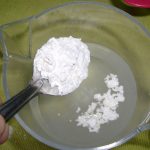 Polysaccharide, a polymer of glucose units; the form in which carbohydrate is stored in the plant; it does not occur in animal tissue.
Polysaccharide, a polymer of glucose units; the form in which carbohydrate is stored in the plant; it does not occur in animal tissue.
A white, odorless, tasteless complex carbohydrate produced in plants as an energy store.
A polymer of glucose molecules (i.e., a polysaccharide) used by plants to store energy. Starch is broken down by enzymes (amylases) to yield glucose, which can be used as an energy source. The analogous polymer that is used by mammalian systems is called glycogen or, in old usage, animal starch.
The usual form in which carbohydrates exist in food, especially in bread, rice and potatoes. It is broken down by the digestive process into forms of sugar.
A carbohydrate found in cereals, potatoes, bananas and other plant materials, and the largest nutrient present in a normal diet. Chemically, starch consists of units of glucose, into which it is broken down during digestion.
A glucose polymer having a-1,4 and a-1,6 linkages.
Starches are long, sometimes highly branched-chains of glucose units (polysaccharides) linked by glycosidic bonds. Amylose and amylopectin are polyscaccharides that are collectively referred to as starches.
The form in which carbohydrates are stored in many plants and a major constituent of the diet. Starch consists of linked glucose units and occurs in two forms, a-amylose and amylopectin. In α-amylose the units are in the form of a long unbranched chain; in amylopectin they form a branched chain. The presence of starch can be detected using iodine: α-amylose gives a blue color with iodine; amylopectin a red color. Starch is digested by means of the enzyme amylase.
A substance belonging to that group of carbohydrates known as the amyloses. It is the form in which utilisable carbohydrate is stored in granules within the seeds and roots of many plants. It is converted into sugar when treated with heat in presence of a dilute acid. Starch is used as a constituent of dusting powders for application to chafed or irritable areas of the skin.
A bath consisting of 1 lb (454 g) of starch mixed into cold water, with boiling water added to make a solution of gluelike consistency, then added to 30 gal (114 L) of water.
Plant polysaccharides composed of glucose that are digestible by humans. Staple grains often comprise 50% to 58% of caloric intake. Salivary and pancreatic amylases hydrolyze starches to dextrin and maltose. These in turn are hydrolyzed to glucose, which is absorbed in the bloodstream. Glucose not immediately needed for energy is converted into glycogen and stored in the liver and muscle.
A lengthy, ramified or unramified succession of hundreds or thousands of glucose particles united together.
This is a description of a substance that is a complex carbohydrate chemically. In practical usage, it is a white, odorless, tasteless, granular or powdery substance that is found in many food plants, but is especially abundant in corn and potatoes.
Starch, a carbohydrate of intricate nature, surpasses the simplicity of sugar in its molecular composition. During the process of digestion, this complex entity undergoes a profound transformation, as it is meticulously dismantled into its elemental form: sugar. It is only in this transformed state that the body can readily absorb and assimilate its nourishing essence.
